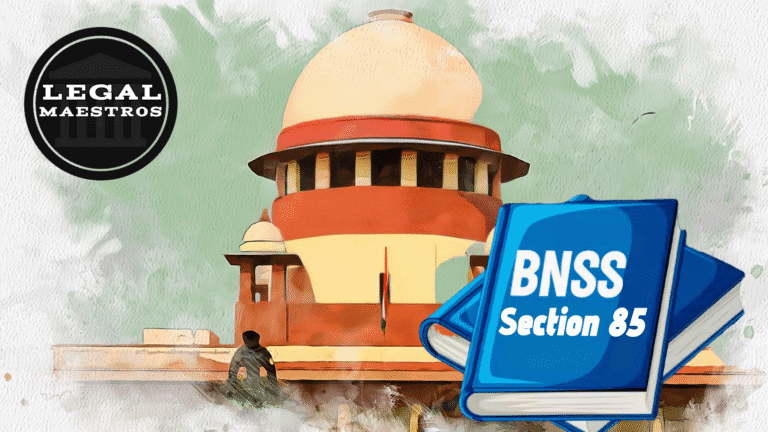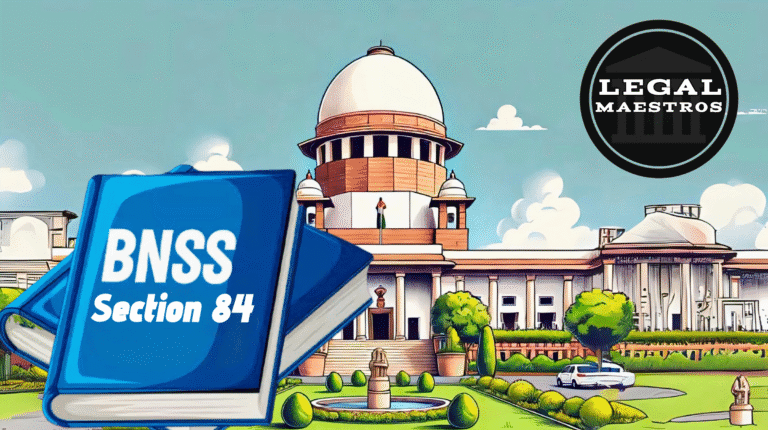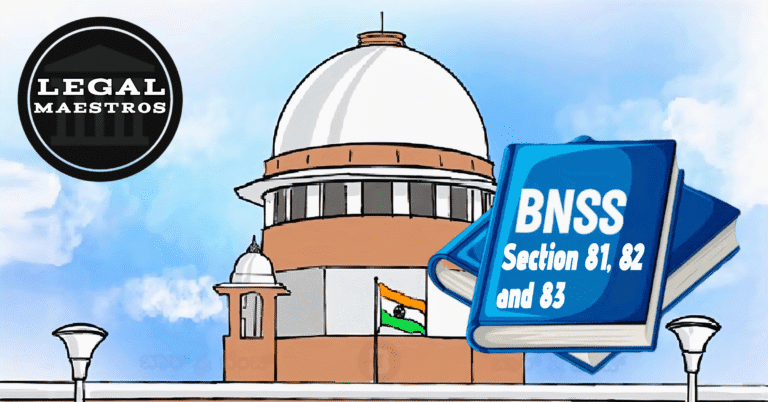
One of the most extensive legal frameworks in India, the Bharatiya Nagarik Suraksha Sanhita, 2023, is intended to replace the more traditional criminal procedure rules. When it comes to the regulation of arrest and custody proceedings, Sections 60, 62, and 63 are particularly significant among the different rules that it contains. These parts guarantee that legal procedures are adhered to in a stringent manner while simultaneously protecting both the interests of the state and the liberties of individuals. The purpose of this article is to provide clarity by examining each of these aspects in an in-depth manner and providing explanations and pictures.
Section 60: Discharge of Person Apprehended
It is the responsibility of Section 60 to determine the circumstances under which an individual who has been arrested may be released from custody. An individual who has been arrested by a law enforcement official is not permitted to be released without a valid legal process or without being subject to arbitrary dismissal, as stated in this provision. One of the following three potential channels must be adhered to in order for the release to be valid:
- On his own bond: This indicates that the person who was arrested have the ability to be released if they provide a personal guarantee that they will appear before the court as necessary. The individual who has been arrested is required to make a bond, which is a commitment to return for subsequent judicial processes. This promise is typically made without the need for any monetary security.
- Regarding bail: when a person is released on bond, they are required to post a monetary guarantee that guarantees they will appear in court for the proceedings. The severity of the offense, the severity of the danger of fleeing, and the possibility of tampering with evidence are all factors that might determine whether or not bail is granted. This strikes a balance between the requirements of the criminal justice system and the individual’s right to personal liberty.
- In accordance with a Magistrate’s special order: In some circumstances, a Magistrate has the authority to actively intervene and issue an order for the release of an individual who has been arrested. In most cases, this occurs in unusual or extraordinary circumstances, such as when there is wrongful imprisonment or when the legal reasons for ongoing custody are either insufficient or nonexistent. Example: [Figure]Suppose Ramesh gets taken into custody for a minor altercation that occurred in a public park. It has been determined by the police station that the offense is eligible for bail. After concluding the signing of a bond that guarantees his presence in court, Ramesh is subsequently granted permission to return home. The situation would be considered a release on bond in accordance with Section 60. On the other hand, if Ramesh was suspected of a severe crime that deserved judicial consideration, his release might be contingent on an order from a magistrate. Providing protection to individuals against unlawful detention and ensuring that the procedure of arrest and release adheres to the principles of due process of law are two of the most important functions that Section 60 fulfills.
For More Updates & Regular Notes Join Our Whats App Group (https://chat.whatsapp.com/DkucckgAEJbCtXwXr2yIt0) and Telegram Group ( https://t.me/legalmaestroeducators )
For any queries or to publish an article or post or advertisement on our platform, do call at +91 6377460764 or email us at contact@legalmaestros.com.
Section 61: Power, on Escape, to Pursue and Retake
Section 61 establishes the legal basis for pursuing and recapturing individuals who escape from lawful custody or are rescued from it. This includes both lawful and rescued prisoners. Important sub-sections are included in this section.
The right to pursue and retake is outlined in subsection (1).
If a person who is lawfully in custody is able to escape or is rescued by other individuals, the person from whose custody the escape happened has the instant authority to pursue and arrest the person who escaped from custody. This pursuit is not limited to any particular geographical boundaries and can be carried out whenever and wherever it is desired inside India.
Once a person is in legal custody, whether by the police, jail officials, or any other authorized person, an escape from such custody can be followed up with quick and legally action to recapture the person, regardless of where they run within the country. This is the case regardless of the location of the person’s escape.
For any queries or to publish an article or post or advertisement on our platform, do call at +91 6377460764 or email us at contact@legalmaestros.com.
Even if a convicted individual who is serving a sentence in a jail in Delhi manages to escape, the authorities in charge of the jail or the police officers can begin a pursuit and apprehend the individual. This is true even if the individual flees to another state, such as Maharashtra. Because of the statute, they are able to carry out this action without having to wait for formal warrants or permits from other states.
The applicability of Section 44 is discussed in subsection (2).
This sub-section makes it clear that the regulations of Section 44 of the Sanhita, which deals with the way in which arrests are made, will apply even to pursuits of this nature. Notably, the individual who makes the arrest does not necessarily have to be a law enforcement officer or be acting in accordance with a warrant. It is because of this clause that the fugitive can be legally arrested but at the same time the procedures that are associated with arrests are maintained.
This indicates that the legal framework of arrest, as specified in Section 44, must be adhered to even in the event that a non-police-related individual, such as a prison guard, is involved in the process of recapturing the escapee. By preventing abuses throughout the process of recapture, these precautions ensure that individuals maintain their dignity.
For any queries or to publish an article or post or advertisement on our platform, do call at +91 6377460764 or email us at contact@legalmaestros.com.
Consider the following scenario: a prison warden is riding in a train when he or she comes across a person who has escaped from custody. Despite the fact that the warden is not a law enforcement officer, he is able to lawfully apprehend the escapee, as stipulated by Section 61(2), provided that he adheres to the regulations outlined in Section 44.
Section 62: Arrest to be Made Strictly According to Sanhita
By saying unequivocally that no arrest shall be made unless it is in compliance with the terms of the Bharatiya Nagarik Suraksha Sanhita, 2023 or any other law that is in effect at the time, Section 62 reaffirms the importance of lawful arrests.
This provision serves as a precaution against arrests that are made without warrant. It suggests that every arrest must be justified by law and must conform with the procedures given out in the Sanhita or other legal regulations. Moreover, it requires these procedures to be followed.
For any queries or to publish an article or post or advertisement on our platform, do call at +91 6377460764 or email us at contact@legalmaestros.com.
To comply with this provision, you must:
In order for the arrest to be legal, the reasons for the arrest must be valid.
The individual under arrest must be made aware of the reasons for their detention.
For any queries or to publish an article or post or advertisement on our platform, do call at +91 6377460764 or email us at contact@legalmaestros.com.
Arrests are required to be carried out by authorized individuals and in accordance with the approved procedure.
Consider the following scenario: a citizen is taken into custody by a person who claims to be a law enforcement officer, but they do not present any form of identity or provide any explanation for the arrest. In accordance with Section 62, an arrest of this kind would be unlawful if the individual in question did not adhere to the procedures that were mandated by the Sanhita.
Including Section 62 in the Constitution not only helps to establish the rule of law but also offers citizens a significant protection against the abuse of power by authoritative figures. In addition to ensuring accountability and openness, it guarantees compliance with due process.
For any queries or to publish an article or post or advertisement on our platform, do call at +91 6377460764 or email us at contact@legalmaestros.com.




![Research Assistantship @ Sahibnoor Singh Sindhu, [Remote; Stipend of Rs. 7.5k; Dec 2025 & Jan 2026]: Apply by Nov 14, 2025!](https://legalmaestros.com/wp-content/uploads/2025/11/Gemini_Generated_Image_s0k4u6s0k4u6s0k4-768x707.png)
![Karanjawala & Co Hiring Freshers for Legal Counsel [Immediate Joining; Full Time Position in Delhi]: Apply Now!](https://legalmaestros.com/wp-content/uploads/2025/11/Gemini_Generated_Image_52f8mg52f8mg52f8-768x711.png)
![Part-Time Legal Associate / Legal Intern @ Juris at Work [Remote]: Apply Now!](https://legalmaestros.com/wp-content/uploads/2025/11/ChatGPT-Image-Nov-12-2025-08_08_41-PM-768x768.png)
![JOB POST: Legal Content Manager at Lawctopus [3-7 Years PQE; Salary Upto Rs. 70k; Remote]: Rolling Applications!](https://legalmaestros.com/wp-content/uploads/2025/11/ChatGPT-Image-Nov-12-2025-08_01_56-PM-768x768.png)